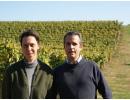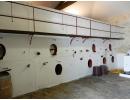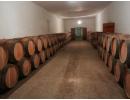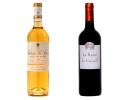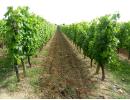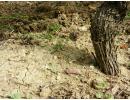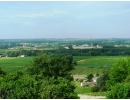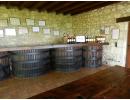Chateau La Rame
Château La Rame "Réserve du Château" – Sainte Croix du Mont
A premium dessert wine made from fully botrytised (noble rot) Semillon grapes from a selection of the best parcels representing 3 ha. The old vines averaging 50 years old produce a low yield of 17 hl/ha. The "Réserve" is only produced if the vintage allows a high quality wine. After a slow press the fermentations are carried out in new french oak barrels at cellar temperature that can take 2 to 4 weeks at 20-23°C. The wine's sugar residual after the fermentation averages 150g/l depending on the vintage. The ageing will be done in the same oak barrels of which 1/3 are new each year and will last for 18 to 24 months depending on the vintage.
PVins notes: A complex and concentrated nose of honey, dried apricots, confit orange peel with subtle aromas of white flowers and hints of vanilla. After an elegant attack, the palate develops a powerful rich body that is well-balanced by the freshness. The oak is well integrated and subtle, the finish is expressive, complex and long. Ideally the wine deserves 3 years cellaring before enjoying it and it will evolve elegantly over a couple of decades like a great Sauternes.
Château La Rame "La Charmille" 2015 – Cadillac Côtes de Bordeaux
The wine's blend is 60% Merlot and 40% Cabernet Sauvignon. The 5 ha of vines planted on clayey-limestone soils have an average age of 50 years old producing a yield of 45 hl/ha. The grapes are destemmed and the fermentations in stainless steel vats will last about 2-3 weeks at 25°C - 30°C. As for the ageing process, the two grape varieties are aged separately in french oak barrels for 12-14 months with 1/3 of new oak each year.
PVins notes: Expressive nose of black berries, cassis, plums, well integrated oak aromas fill the glass with hints of licorice and mocha. The tannins are elegant and fine grained, well structured and balanced, medium-bodied, a long fresh aromatic finish. It has a cellaring potential of 5 to 10 years depending on the vintage.
Press: Wine Enthusiast 91
This is a ripe, smoky wine with fine tannins and rich black fruit. Dense with black chocolate and damson flavors, it gives concentration and richness and will age well. Drink from 2020.
Château La Rame, “La Rame” meaning rock in old French, is located 40 kms to the south-east of the city Bordeaux in the Entre Deux Mers sub-region. It is situated on top of a hill on the left bank of the Garonne river overlooking Sauternes in the distance. The Château was the property of the Baron de Vertheuil during the French Revolution. In the late 19th century, the wine produced by Château La Rame was already considered to be the best dessert wine in the area winning a Gold Medal at the Universal Exhibition in Bordeaux in 1895 and also in Paris in 1900. In those days wine merchants of Bordeaux already regarded Château La Rame to be equivalent to a 1st Growth from Sauternes.
In 1956, Claude ARMAND acquired the 20 ha estate knowing the reputation of Château La Rame, as the family has a long history of working in the appellation’s vineyards from generation to generation. Claude started by improving the state of the vineyard and in 1969 with the help of his son Yves, they started restructuring the cellar to give back the Château its glorious reputation. Yves took over the running of the Château in 1980 and continued to strive for perfection. By passion and wanting to take the quality of the wine a step further, in 1983 Yves decided to create a special premium cuvée the “Réserve du Château”. Soon the French wine critics called it the local “Yquem” due to its excellent quality in reference to the famous Château d’Yquem from Sauternes, located on the opposite side of the Garonne river. It is of 1er Cru Classé quality as it often surpasses many Growth wines of Sauternes in blind tastings. In 1995 Robert Parker described the “Réserve du Château 1990” as a combination of Château Climens a 1st Growth of Barsac and Château Suiduiraut a 1st Growth of Sauternes. In 2000 a new cellar of 1,000m² was build to further improve the quality of the winemaking process and also increase the cellaring space. Since 2009 Château La Rame is managed by Yves’s children Grégoire and Angélique with her husband Olivier Allo, but Yves still has a watch-full eye on the estate.
Château La Rame also owns 8 ha of vineyards in the neighbouring appellation Cadillac, the parcels were purchased in the 1950s. The parcels with old vines are located on the plateau of Monprimblanc to the north of Sainte Croix du Mont. Under the name Château La Rame the family now also produce Bordeaux reds, whites, a rosé and a sweet Cadillac. The premium red "La Charmille" Cadillac Côtes de Bordeaux is named after the lieu-dit of the same name which derives from a type of tree planted on the estate called "charme" .
The heart of Château La Rame represents 20 ha of vines facing south on slopes overlooking the Garonne river. From this height on a clear day you can see Château d’Yquem in the distance and other Growth Châteaux of Sauternes. The soil structure consists of clay-limestone with an exceptional basement in depth characterised by a fossilised oyster bed dating from the geological Tertiary era. The main grape variety planted is Semillon (75%) followed by Sauvignon Blanc (25%) and the vines have an average age of 50 years old.
From September to November the wonder of nature comes into play. Like in Sauternes and Barsac across the river, the area benefits from the influence of the Ciron tributary. The Ciron creek which originates from the pine forest of "Les Landes" and flowing through Sauternes, creates a micro-climate with its cooler waters that flow into the warmer waters of the Garonne. The difference in temperature between the two waters creates a mist early evening that hangs till morning, the moisture combined with the afternoon sun will promote the establishment and progressive development of the Botrytis Cinerea (noble rot) on the ripe grapes. This fungus will allow the grapes to reach the over maturity sought, concentrating sugars and flavours. The handpicked harvest of the “Réserve du Château” spreads over October into November needing up to 6 pickings "tries" depending on the vintage. The grapes are brought to the cellar within 2 hours after picking.
On the plateau Monprimblanc situated in the commune of Cadillac to the north of sainte Coix du Mont, Château la Rame aquired in the 1950s parcels totalling 8 ha. Here, Bordeaux reds, a rosé, dry whites and a dessert wine are produced. The vines averaging 50 years of age are planted on calcareous clay and molasses soils with a southerly exposure. The main grape variety planted for the reds is Merlot followed by Cabernet Sauvignon, also planted are the varieties Semillon and Sauvignon Blanc to produce Bordeaux dry whites and a sweet Cadillac.
The premium wine of Château La Rame “Réserve du Château” is made from the best parcels representing 3 ha. It is only produced if the vintage allows a high quality, if this is not possible the “Réserve” will not be made such as in 2008. Since 2009, the wine is produced from 100% Semillon as sauvignon Blanc is no longer part of the blend. During the harvest the fully botrytised grapes with their high sugar concentration are carefully handpicked producing a very low yield of 17 hl/ha on average, similar to the great wines of Sauternes up to 6 tries are usually necessary. In 1998 Yves Armand decided to do the fermentations in oak barrels following a slow press, the fermentations can take 2 to 4 weeks at 20-23°C. Should the fermentations need a little help to start, concrete vats will be used for the first 12 to 24 hours to facilitate the start of the fermentations. Once they have started the juice will be transfered in the oak barrels to continue as normal. The wine's sugar residual after the fermentations averages 150g/l depending on the vintage. The ageing will be done in the same oak barrels of which 1/3 are new and will last for 18 to 24 months depending on the vintage.
At least a couple of years of cellaring is recommended for this premium cuvée “Réserve” upon release, it needs time to start showing its full potential and it will age beautifully over a couple of decades. The important element of producing great dessert wines is to find the right balance between the richness and the natural acidity. This balance helps not to produce a wine that feels too rich and syrupy on the palate. The "Réserve du Château'" has a complexity of flavours and mouthfeeling structure that makes the waiting worthwhile, that is if you can resist the temptation of drinking this nectar when young.
The grapes for the premium red Château La Rame "La Charmille" are hand-picking at full maturity. The 50 year old vines produce an average yield of 45 hl/ha. A first sorting is done in the vineyard and a second sorting is done on arrival at the cellar using sorting tables. The grapes are then destemmed before the pressing. The wine's blend is 60% Merlot and 40% Cabernet Sauvignon. The fermentations in stainless still vats will last about 15-20 days at 25°C to 30°C. For the ageing process, the two grape varieties are aged separately in french oak barrels for 12-14 months (1/3 new). After the ageing the wine is blended and château bottled.
Links: Sainte Croix du Mont - Cadillac map - Bordeaux map
SAINTE CROIX DU MONT
The Sainte Croix du Mont appellation was created in 1936. It is located 40 kilometres to the south-east of Bordeaux within the Entre Deux Mers sub-region, situated on the Right Bank of the Garonne river. The commune covers 850 hectares with 450 hectares planted. The appellation is well known for its dessert wines as they are very similar to Barsac and Sauternes wines from the opposite side of the Garonne river. The wines are made from late picked harvests once the botrytis cinerea (noble rot) has developed on the grapes.
History
The local history can be traced since the conquest of Gaul by Jules Caesar and until 471AD. The Romans occupied the region and undertook the work to highlight the fertile lands near the Garonne river by clearing the hillsides and planting the first vines. In 1153, the Aquitaine region will undergo a change which will mark 3 centuries of its history: it becomes an English province until 1455. Eleanor, the daughter of the Duke of Aquitaine, brought the region in dowry to the King of England Henry II Plantagenet and Sainte-Croix-du-Mont enters a prosperous period. During the 12th century the English built a fortress the castle of Tastes, which dominates the Valley and at the same time, in 1235, they also build a church still present today. Trade is now thriving for the wine merchants, the navigation on the Garonne is in full swing, the barges are loaded with barrels leaving for England from the port of Sainte-Croix-du-Mont. In 1453, the English influence draws to a close and the entire region is given back to the King of France. Political stability is reborn and the area is prosperous. At the beginning of the 16th century, the castle of Tastes belongs to François de Léon, his tombstone can be found next to the Church. In the 18th century, we find traces of bourgeois (nobles) of Bordeaux, who seduced by the location, settled and built elegant mansions surrounded by their vineyards. In the 19th century, as everywhere else in France, the vineyard of Sainte-Croix-du-Mont is damaged by the phylloxera. However, the wine trade and the traffic via the Port du Peyra on the Garonne river continues. Today the appellation benefits from a good reputation as a source of quality dessert wines, with the top wines of some estates matching the quality of some of the 1855 Grand Cru Classé of Sauternes at a lower price.
Vineyard
The vineyards of the appellation Sainte-Croix-du-Mont are planted on plateaus and steep hillsides with a Southwest exposure, with an altitude reaching over 100 metres. The soil structure is stony clayey-calcareous dating from the Oligocene and Miocene periods. The subsoil is formed of huge fossilised oyster beds accumulated during the geological Tertiary era 20 million years ago, in this huge layer of several metres deep, some châteaux have dug some spectacular caves. Alluvial deposits during the Quaternary era are found on terraces.
The main grape variety planted is Semillon (85%) followed by Sauvignon Blanc (12%) and Muscadelle (3%). Dry white wines are also produced in the area under the appellation Bordeaux. The making of these great dessert wines begins with the harvest starting late September early October, when the grains are perfectly covered with noble rot, the harvesting period will last 5 to 9 weeks. Since the action of the Botrytis is not regular and the development of the noble rot on the bunches is more or less fast and localized, the handpicking of the grapes is fragmented by successive tries which may require 4 to 8 pickings. As the development of the noble rot results in the reduction of the grape's volume, but increases its sugar content, the average yield is barely more than 30 hectolitres per hectare.
The wines of Sainte-Croix-du-Mont offer remarkable flavours and aromas of dried raisins, ripe fruit (apricot, peach), honey and also white flowers with delicate perfumes of acacia and honeysuckle. On the palate they are very pleasant, firm and generous, full-bodied with elegant fruity aromas that linger. Drunk young they are fresh and fruity, while the great vintages can age several decades.
Climate
Like most of the Bordeaux wine region, the Sainte Croix du Mont area has a maritime climate which brings the viticultural hazards of autumn frost, hail and rains that can ruin an entire vintage. Like Sauternes and Barsac on the opposite of the Garonne river it benefits from the influence of the Ciron tributary. The Ciron creek which originates from the pine forest of "Les Landes", creates a micro-climate in the area with its cooler waters that flow into the warmer waters of the Garonne. In the autumn, when the climate is warm and dry, the different water temperatures between the two at their meeting point produce a mist that descends upon the vineyards from evening to late morning. This condition promotes the development of the Botrytis cinerea. By mid day, the warm sun will help dissipate the mist and dry the grapes to keep them from developing a less favorable rot known as the gray rot.



